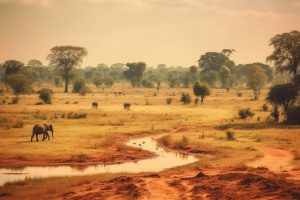Are you planning to go on a safari in Kenya? You may already know that Kenya is one of the best safari destinations in Africa. But did you know there are many unknown historical facts about Kenya safaris? In this article, we will take a closer look at some of the lesser-known and fascinating facts about safaris in Kenya.
1. The word “safari” comes from Swahili
The word “safari” comes from the Swahili language, native to Kenya and Tanzania. It means “journey” or “travel.” Swahili is a Bantu language and is one of the most widely understandable languages in Africa.
It is the official language of Kenya and Tanzania and is also spoken in parts of Uganda, Rwanda, Burundi, and the Democratic Republic of Congo.
2. The first recorded safari to Kenya took place in 1836
Kenya has a rich safari history that dates back to the early 19th century. The first recorded safari to Kenya took place in 1836 when a British explorer named William Cornwallis Harris went on a hunting expedition in the country. Harris was an experienced hunter and had previously been on expeditions to South Africa and the Arabian Peninsula. During his safari in Kenya, he hunted elephants, rhinos, and other big game animals.
3.Kenya’s first national park was established in 1946
Kenya’s first national park, the Nairobi National Park, dates as far back as 1946. The park is located just a few miles from the center of Nairobi, the capital city.


It covers an area of 117 square kilometers and is home to a wide range of wildlife, including lions, leopards, cheetahs, hyenas, buffalos, and giraffes. The park is also home to over 400 species of birds.
4. Kenya’s safari industry has shifted from hunting to eco-tourism
In the early days of Kenya’s safari industry, hunting was a popular activity. However, in the 1970s, Kenya banned hunting, and the focus of the safari industry shifted to wildlife photography and eco-tourism. Today, visitors to Kenya can go on safari tours that focus on wildlife observation and conservation. The safari industry has become a vital part of Kenya’s economy, providing employment for thousands of people and generating millions of dollars in revenue.
5. Kenya’s Masai Mara National Reserve is home to the Great Wildebeest Migration
Kenya’s Masai Mara National Reserve is one of the most popular safari destinations in Africa. The reserve covers an area of 1,510 square kilometers. It is home to a wide range of wildlife, including lions, leopards, cheetahs, hyenas, elephants, buffalos, and giraffes. But the most famous attraction in the reserve is the Great Wildebeest Migration.


Every year, millions of wildebeest, zebras, and other animals migrate from Tanzania’s Serengeti National Park to Kenya’s Masai Mara in search of fresh grazing lands. The migration is one of the most spectacular wildlife events in the world and is a must-see for anyone visiting Kenya.
6. Queen Elizabeth II went on a safari in Kenya in 1952
In 1952, a young British princess named Elizabeth (who would later become Queen Elizabeth II) went on a safari in Kenya with her husband, Prince Philip. The couple stayed at the Treetops Hotel in the Aberdare National Park. There, they learned that Elizabeth’s father, King George VI, had died, making her the new queen. The Treetops Hotel is now a popular safari destination in Kenya for its stunning views of wildlife.
7. Kenya’s safari industry suffered a downturn in the 1980s and 1990s
In the 1980s and 1990s, Kenya’s safari industry suffered a downturn due to political instability and poaching. Poaching was a major problem during this time, and many of Kenya’s wildlife populations were decimated.


However, in the late 1990s and early 2000s, the government and conservation organizations launched a successful anti-poaching campaign, and Kenya’s wildlife populations began to recover. Today, Kenya’s safari industry is thriving, and the country is once again one of the top safari destinations in Africa.
8. Kenya’s first female safari guide was trained in 1983
In 1983, Kenya’s first female safari guide, Jacinta Nzioka, was trained by the Kenya Wildlife Service. Nzioka broke barriers and paved the way for other women to enter the male-dominated safari industry. Today, there are many female safari guides in Kenya, and they are highly respected for their knowledge and expertise.
9. Kenya’s safari lodges are among the most luxurious in Africa
Kenya’s safari lodges are famous for their luxury and comfort. Many of the lodges are located in remote areas and offer stunning views of the African landscape.


Some lodges even have their own private airstrips, allowing visitors to arrive in style. Many of the lodges also offer spa treatments, gourmet cuisine, and other amenities to make visitors’ safari experience as comfortable and enjoyable as possible.
10. Kenya is home to some of the most endangered wildlife species in the world
Kenya is home to some of the most endangered wildlife species in the world, including the black rhino, white rhino, the Grevy’s zebra, and the mountain bongo.


The country has launched several conservation initiatives to protect these species and their habitats. Visitors to Kenya can support these conservation efforts by visiting national parks and reserves and learning more about the country’s wildlife.
Conclusion
Kenya has a rich safari history and is one of the best safari destinations in Africa. The country’s safari industry has evolved from hunting to eco-tourism, and visitors can now go on safari tours that focus on wildlife observation and conservation. Ideally, opt for 4×4 vehicles such as the Toyota Prado, Honda CRV, Toyota Harrier and others.
Kenya is also home to some of the most endangered wildlife species in the world, and the country has launched several conservation initiatives to protect these species and their habitats. Whether you’re a first-time visitor or a seasoned traveler, Kenya’s safaris offer a unique and unforgettable experience that you won’t find anywhere else.


